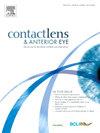Development and psychometric evaluation of beliefs about the orthokeratology lens compliance scale (BOLCS): Based on the theory of planned behavior
IF 3.7
3区 医学
Q1 OPHTHALMOLOGY
引用次数: 0
Abstract
Purpose
Non-adherence to standard wear, care, and follow-up procedures is a major risk factor for contact lens-related complications. The effectiveness of orthokeratology largely depends on the wearer's adherence. However, a deficiency in scales capturing adherence beliefs pertinent to orthokeratology exacerbates the lack of guidance for effective intervention strategies. The purpose of this study is to develop and evaluate the psychometric properties of a new scale based on the Theory of Planned Behavior that assesses the level of adherence among ortho-k wearers.
Methods
This study involved three stages following the STROBE checklist: (1) developing initial scale items based on the Theory of Planned Behavior, a literature review, and a qualitative study; (2) evaluation of content and face validity; (3) psychometric testing on 296 participants. Item analysis, based on Classical Test Theory, assessed the overall consistency, reliability, and validity of the scale.
Results
The final 37-item Beliefs about the Orthokeratology Lens Compliance Scale (BOLCS) comprises 11 dimensions. The Cronbach's alpha coefficients for each dimension ranged from 0.560 to 0.798. The folded half reliabilities were 0.845, and the combined reliabilities ranged from 0.676 to 0.793, indicating strong reliability. Item-level CVI (I-CVI) and scale-level CVI/average (S-CVI/Ave) values, assessed by the panel, ranged from 0.71 to 1 and 0.954, respectively. Exploratory and confirmatory factor analyses supported a factor structure consistent with the theoretical model.
Conclusions
The scale's construction adhered to a standardized process, yielding preliminary validation results with satisfactory reliability and validity.
角膜塑形镜依从性信念量表(BOLCS)的开发与心理测量评估:基于计划行为理论。
目的:不遵守标准配戴、护理和后续程序是隐形眼镜相关并发症的主要风险因素。角膜矫形术的效果在很大程度上取决于配戴者的依从性。然而,由于缺乏与角膜矫形术相关的坚持信念量表,因此更缺乏有效干预策略的指导。本研究的目的是在计划行为理论的基础上开发并评估一种新量表的心理测量特性,以评估角膜矫形佩戴者的依从性水平:本研究按照 STROBE 检查表分为三个阶段:(1) 根据计划行为理论、文献综述和定性研究制定初始量表项目;(2) 评估内容效度和表面效度;(3) 对 296 名参与者进行心理测试。基于经典测验理论的项目分析评估了量表的整体一致性、可靠性和有效性:最终的 37 个项目的 "角膜塑形镜符合性信念量表"(BOLCS)包括 11 个维度。每个维度的 Cronbach's alpha 系数在 0.560 到 0.798 之间。折半信度为 0.845,综合信度为 0.676 至 0.793,表明信度很高。由专家小组评估的项目级 CVI(I-CVI)和量表级 CVI/平均值(S-CVI/Ave)分别为 0.71 至 1 和 0.954。探索性和确认性因素分析支持与理论模型一致的因素结构:该量表的构建遵循了标准化流程,初步验证结果的信度和效度令人满意。
本文章由计算机程序翻译,如有差异,请以英文原文为准。
求助全文
约1分钟内获得全文
求助全文
来源期刊

Contact Lens & Anterior Eye
OPHTHALMOLOGY-
CiteScore
7.60
自引率
18.80%
发文量
198
审稿时长
55 days
期刊介绍:
Contact Lens & Anterior Eye is a research-based journal covering all aspects of contact lens theory and practice, including original articles on invention and innovations, as well as the regular features of: Case Reports; Literary Reviews; Editorials; Instrumentation and Techniques and Dates of Professional Meetings.
 求助内容:
求助内容: 应助结果提醒方式:
应助结果提醒方式:


